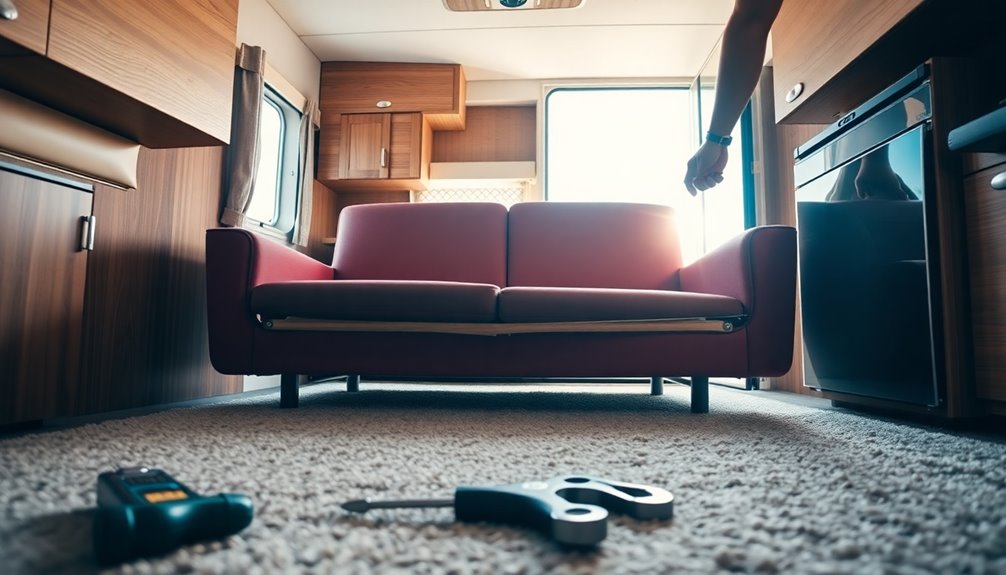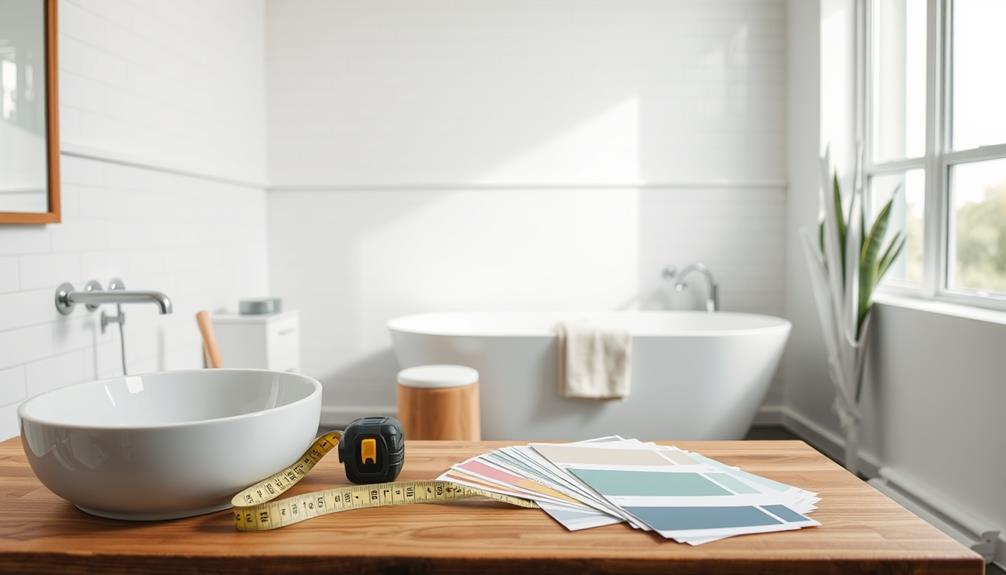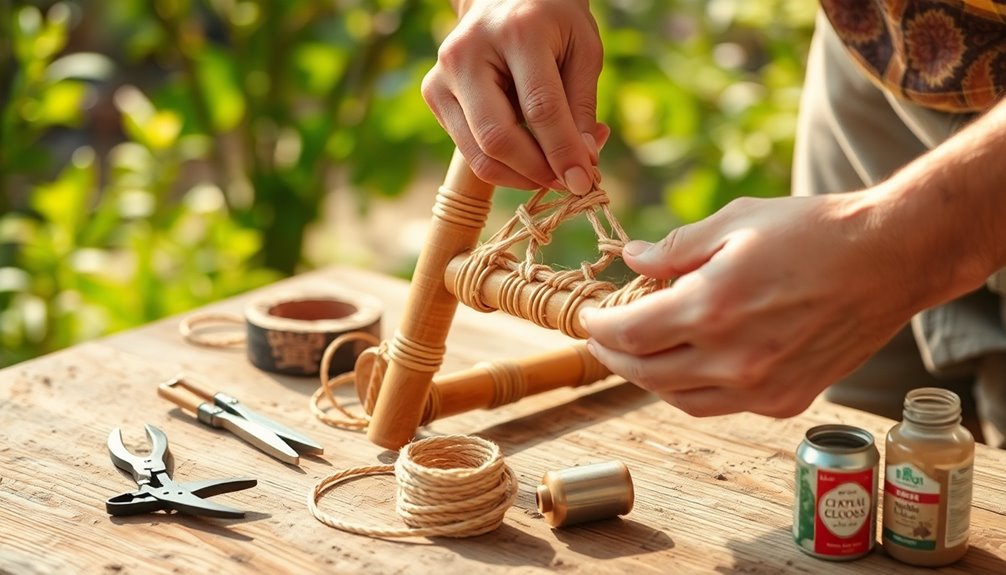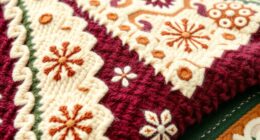To remove a sofa from your RV, start by checking for any screws or fasteners that may secure it to the floor or walls. Reinforce the frame if it feels unstable, using brackets for support. Before lifting, make sure to clear the area of obstacles. Keep the sofa out of direct sunlight to prevent fading and damage during removal. If it's heavy, enlist help to distribute the weight properly. Lastly, think about personalized storage solutions for the space left behind. There's plenty more helpful advice to ensure a smooth removal process ahead.
Key Takeaways
- Clear the area around the sofa to ensure ample space for removal and avoid obstacles.
- Inspect and tighten any loose screws or fasteners before attempting to move the sofa.
- Use furniture straps or brackets to secure the sofa during removal to prevent damage.
- Reinforce the couch frame with corner brackets or plywood for stability while lifting.
- Protect surrounding surfaces with blankets or cardboard to avoid scratches or dents during the process.
Introduction
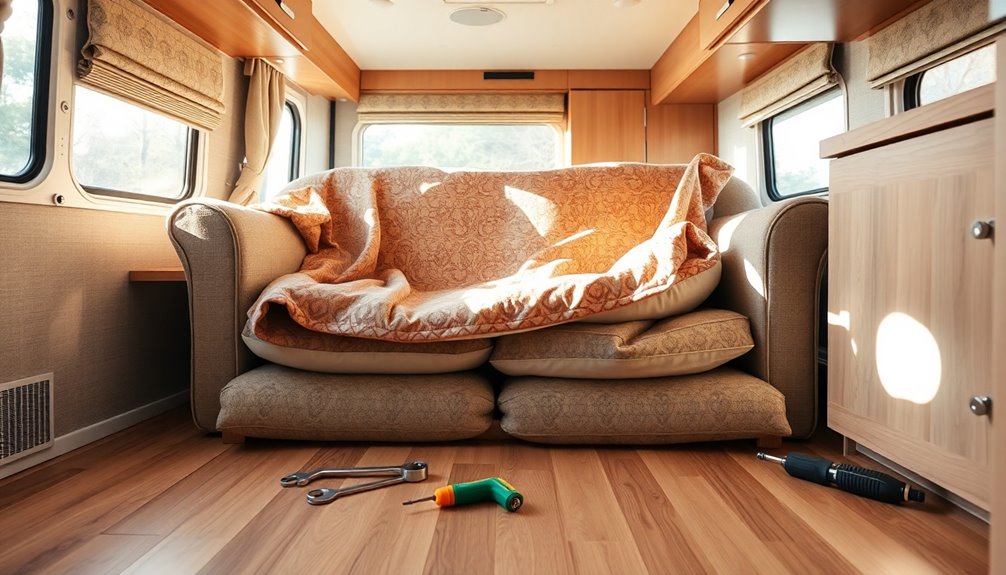
When you're ready to tackle your RV sofa removal, it's also a great time to think about routine upholstery care. Knowing fabric-specific cleaning techniques can help keep your new couch looking fresh, especially if you face any tough stains like red wine spills. Additionally, ensure that you follow proper safety regulations to prevent any accidents during the removal process. Let's explore some essential tips to maintain your RV furniture while making the transition smooth.
Routine Upholstery Care Tips
Maintaining your RV's upholstery is essential for keeping it looking fresh and extending its lifespan. One of the best routine upholstery care tips is to regularly vacuum your upholstery to remove dust and debris. This simple step can significantly prolong the life of the fabric while maintaining its appearance.
To protect against stains and spills, consider using a fabric protector spray specifically designed for upholstery. Just make sure to follow the manufacturer's instructions for application. For minor stains, gently blot the affected area with a clean damp cloth and a mild detergent solution. Avoid using harsh chemicals, as they can damage the fabric.
Don't forget to rotate and fluff your cushions periodically. This practice prevents uneven wear and helps maintain their shape, enhancing both comfort and aesthetic appeal. Lastly, consider scheduling professional cleaning every 1-2 years. This service can effectively remove deep-set dirt and allergens, rejuvenating the fabric's look and feel. By following these routine upholstery care tips, you'll ensure your RV's interior stays inviting and well-maintained for years to come.
Fabric-Specific Cleaning Techniques
Understanding fabric-specific cleaning techniques is crucial for effectively maintaining your RV's upholstery. Different fabric types require specific cleaning methods to keep them looking their best. For instance, microfiber can be cleaned using a mixture of mild soap and water, while leather needs a specialized leather cleaner to prevent damage. Always check the manufacturer's care label before cleaning; it'll tell you if the fabric is water-safe or requires solvent-based cleaners.
When tackling stains, act quickly. For oil-based stains, sprinkle cornstarch on the area to absorb the oil, while water-based stains can be effectively treated by blotting with a clean cloth and mild detergent. Regular vacuuming is essential, too, as it removes dust, dirt, and debris that can degrade fabric quality over time. Additionally, using an air purifier can help reduce allergens and dust in your RV, maintaining a cleaner environment for your upholstery.
If you encounter tough stains or need a deep clean, consider hiring a professional upholstery cleaning service that specializes in RV fabrics. They'll ensure safe and effective treatment tailored to your fabric type. By following these fabric-specific cleaning techniques, you can extend the life of your RV's upholstery and keep it looking fresh and clean.
Tackling Red Wine Spills
Red wine spills can be a nightmare for your RV sofa, but quick action can save the day. As soon as you notice the spill, grab a clean cloth and gently blot the stain. This helps absorb the liquid without pushing it deeper into the fabric. Next, mix one part white vinegar with two parts water, and use a cloth to dab this solution onto the stain. The vinegar will help neutralize the red wine's pigments.
After applying the vinegar solution, sprinkle baking soda over the area. This will lift the stain and absorb any remaining moisture. Let the baking soda sit for 15-20 minutes before vacuuming it up. If the stain proves stubborn, you might want to reach for a commercial upholstery cleaner specifically designed for your RV couch's fabric. Always follow the manufacturer's instructions for best results.
Before you apply any cleaning solution, don't forget to perform a spot test on a hidden area of the sofa. This simple step ensures that the cleaner won't damage or discolor your upholstery, keeping your RV looking pristine.
Avoiding Direct Sunlight
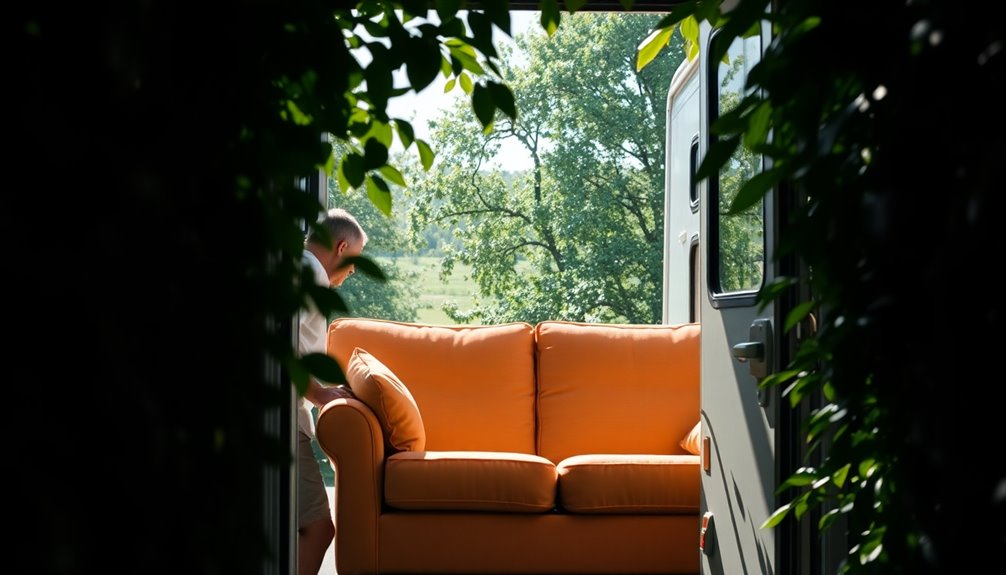
When you're removing your sofa from the RV, keeping it out of direct sunlight is key to preserving its condition. Consider scratch-resistant furniture options and decorative fabric protection solutions to safeguard your sofa against fading and wear. Regular cleaning and conditioning can also help maintain its appearance, making it look great for years to come.
Scratch-Resistant Furniture Options
Choosing the right furniture for your RV can make a significant difference in both comfort and durability. When you're on the road, scratch-resistant furniture is essential for withstanding daily wear and tear. Look for materials like vinyl, leather, or microfiber, which are designed to endure the rigors of RV life.
Additionally, consider UV-resistant fabrics to protect your furniture from fading due to direct sunlight. Since RVs often have limited space and exposure, these fabrics can help maintain the color and integrity of your furniture over time.
Check the rub count of the materials you're considering; a high rub count—30,000 rubs or more—indicates durability and resistance to scratching or fraying. You should also opt for furniture that features protective coatings, like polyurethane, as these enhance scratch resistance while keeping your furniture looking clean and new.
To further safeguard your investment, regularly apply fabric protectants or sprays. These products can help prevent scratches and stains, ensuring your RV furniture remains in great shape for years to come. Prioritize these features, and you'll enjoy both comfort and longevity on your travels. Additionally, understanding state-specific retirement options can provide financial security to support your RV lifestyle as you travel.
Decorative Fabric Protection Solutions
To protect your RV's sofa from the damaging effects of direct sunlight, consider implementing a variety of decorative fabric protection solutions. Start by using UV-protective window films or shades to minimize the sunlight exposure that can cause fabric fading and deterioration. This simple addition can make a significant difference in preserving your sofa's appearance.
Next, think about employing slipcovers made from fade-resistant materials. These slipcovers not only shield your sofa from sun damage but also allow for easy removal and cleaning, keeping your RV looking fresh. Additionally, regularly rotating the cushions can help ensure even sun exposure, preventing one side of the fabric from fading more than the other.
Don't forget to apply fabric protectants specifically designed to resist UV rays. This extra layer of protection helps maintain the color and integrity of your sofa's fabric over time. Lastly, consider positioning your RV strategically to minimize direct sunlight on the sofa or using outdoor awnings to create shade during periods of high sun exposure. By following these tips, you'll keep your RV sofa looking great for years to come.
Regular Cleaning and Conditioning
Maintaining the appearance and longevity of your RV sofa goes beyond just protective measures against sunlight; regular cleaning and conditioning play a vital role too. Start by vacuuming your sofa regularly to remove dust and debris. This step prevents dirt buildup that can lead to stains. For any spots or spills, use a mild detergent solution to spot clean immediately—this helps keep your upholstery looking fresh and clean.
Conditioning your sofa's upholstery is equally important. Applying appropriate fabric protectants can maintain the material's integrity and appearance over time, preventing wear and tear. Remember, avoiding direct sunlight is crucial; it can cause fading and damage to your upholstery. If possible, place your sofa away from sun exposure or use UV-blocking window treatments to create a barrier.
Additionally, periodically rotating your cushions can help distribute wear evenly, extending the lifespan of your sofa. Always follow the manufacturer's care instructions for specific materials to ensure your cleaning and conditioning practices are safe and effective. By incorporating these maintenance tips, you'll keep your RV sofa in great shape for years to come.
Couch Frame Reinforcement Techniques
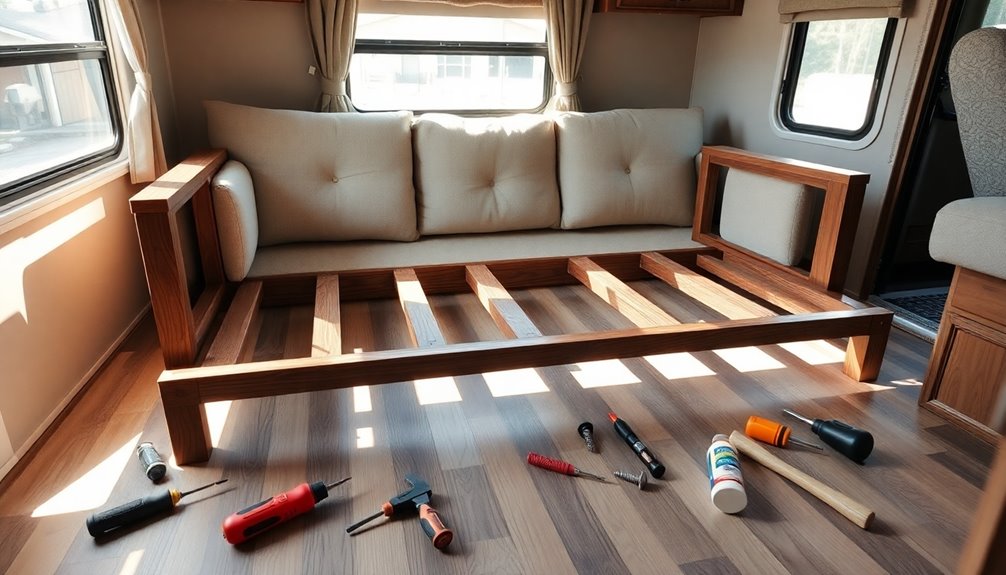
When you're removing your RV sofa, it's crucial to reinforce the couch frame to maintain its stability. You might also want to explore leather repair techniques to address any wear and tear, ensuring your seating remains cozy and inviting. Let's look at effective methods to strengthen your couch and keep it in top shape during the removal process.
Couch Stability Concerns
Many RV owners face couch stability concerns due to the constant movement while traveling. To address these issues, you can take several steps to reinforce the couch frame and ensure it remains secure. Start by adding corner brackets to strengthen the joints, which helps prevent wobbling during transit. If your couch is lacking support, consider placing plywood or MDF boards underneath to distribute weight more evenly.
Next, it's crucial to secure the couch to the RV structure. Use furniture straps or brackets to minimize the risk of shifting while you're on the road. Don't forget to inspect the couch for any loose fasteners or screws; tightening these will enhance stability before you remove or replace it.
If you notice any signs of weakness in the frame, think about reinforcing it with additional wood pieces or metal brackets. This not only extends the life of your couch but also maintains comfort during use. By taking these steps, you can effectively address couch stability concerns and enjoy a safer, more comfortable ride in your RV.
Leather Repair Techniques
You might not realize how crucial leather repair techniques are when removing a sofa from an RV, especially if it's seen better days. Before you start, inspect the couch frame for any loose joints or cracks. Use wood glue and clamps to secure these areas, reinforcing the structure and ensuring it holds up during disassembly. By taking this step, you minimize the risk of further damage.
Next, check for broken sections and consider adding brackets or corner braces for extra support. This reinforcement helps prevent any mishaps while you maneuver the couch out of the RV. If your sofa has leather upholstery, applying a leather repair kit can enhance its durability, allowing it to withstand the stresses of removal without tearing or cracking.
Don't forget to cushion the frame with foam or padding to absorb impacts during the process. After you've removed the sofa, consider reinforcing the frame with a fresh coat of paint or sealant. This not only protects against moisture and wear but also prepares it for reinstallation or disposal. These techniques will help ensure your couch is ready for its next chapter!
Cozy Seating Solutions
For a comfortable and secure RV experience, reinforcing your couch frame is essential. Whether you've got a new couch or an older model, implementing cozy seating solutions can enhance your stability during travel. Start by adding extra L brackets to secure the ends of your couch frame to the RV slide floor. This simple step dramatically boosts stability.
Next, consider utilizing a 1×3 stringer to connect the back and sides of the couch. This provides additional support, preventing sagging over time. Additionally, placing plywood sheets beneath the couch can help distribute weight evenly, maintaining the integrity of the frame during use.
Don't forget to inspect and replace any worn or damaged fasteners with heavy-duty screws. This ensures your couch remains firmly anchored and safe for all occupants. If your couch includes recliners, evaluate using shock-absorbing suspension mechanisms to improve comfort and minimize stress on the frame during movement.
Personalized Storage Solutions
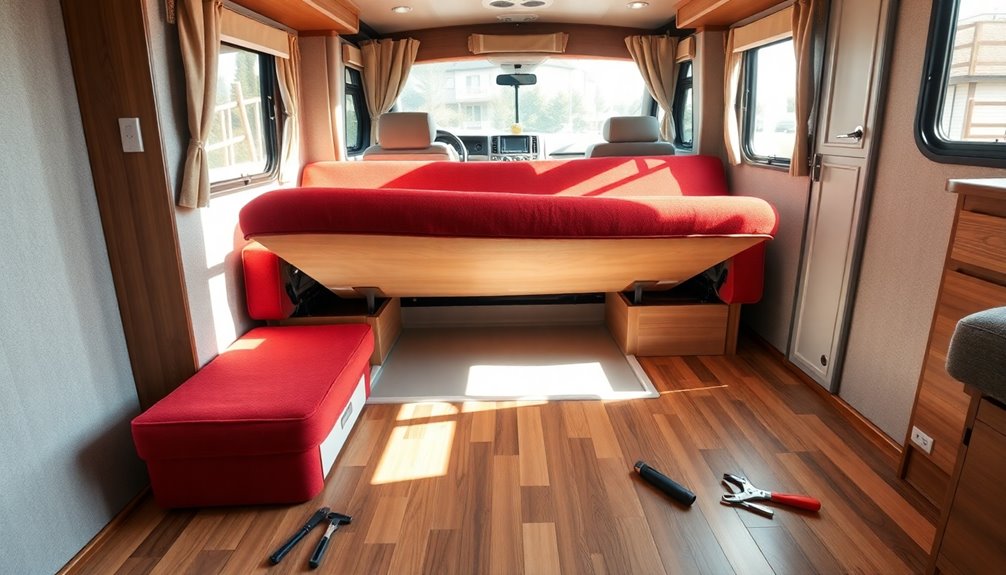
When it comes to maximizing space in your RV, personalized storage solutions are key. After removing your couch, consider utilizing the area for under-sofa compartments. This space can be a goldmine for storing blankets, games, or other items you want to keep out of sight. You might also install built-in shelves or cabinets where the old sofa used to be. This offers additional storage for personal items and gear, helping you stay organized on the road.
Don't forget about multifunctional furniture! Storage ottomans or benches can give you extra seating while hiding away your belongings. Think about incorporating wall-mounted storage solutions, like hooks or organizers, nearby to keep frequently used items readily accessible. These simple additions can make a big difference in your RV's functionality.
Finally, consider collapsible or foldable furniture to create flexible storage options. This approach allows you to adjust your living space as needed, especially when you have guests or require more room. By implementing these personalized storage solutions, you'll not only enhance your RV's organization but also improve your overall travel experience.
Seasonal Storage Best Practices
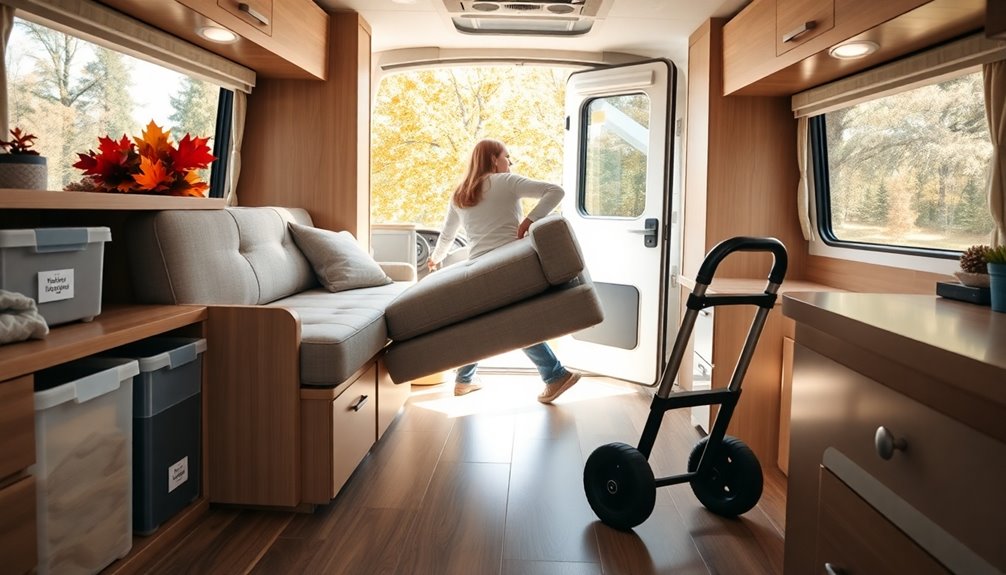
How should you prepare your RV sofa for seasonal storage? First, start by cleaning all surfaces thoroughly. This step is crucial in preventing mold and mildew, especially in humid conditions. Use a gentle cleaner suitable for your sofa material to ensure it's free of dirt and grime.
Next, cover your sofa with a breathable fabric. This protects it from dust and potential damage while allowing for air circulation, which helps avoid moisture buildup. If possible, elevate the sofa off the ground using pallets or furniture risers to prevent it from contacting moisture from the floor during storage.
Temperature control is also important. Keep the storage area at a stable temperature to prevent deterioration of the sofa materials, particularly if you're storing your RV in extreme weather. Lastly, make it a habit to check on your stored sofa throughout the off-season. Look for any signs of pests, moisture, or damage, and address any issues immediately. By following these seasonal storage best practices, you can ensure your RV sofa stays in great condition until you're ready to use it again.
Conclusion
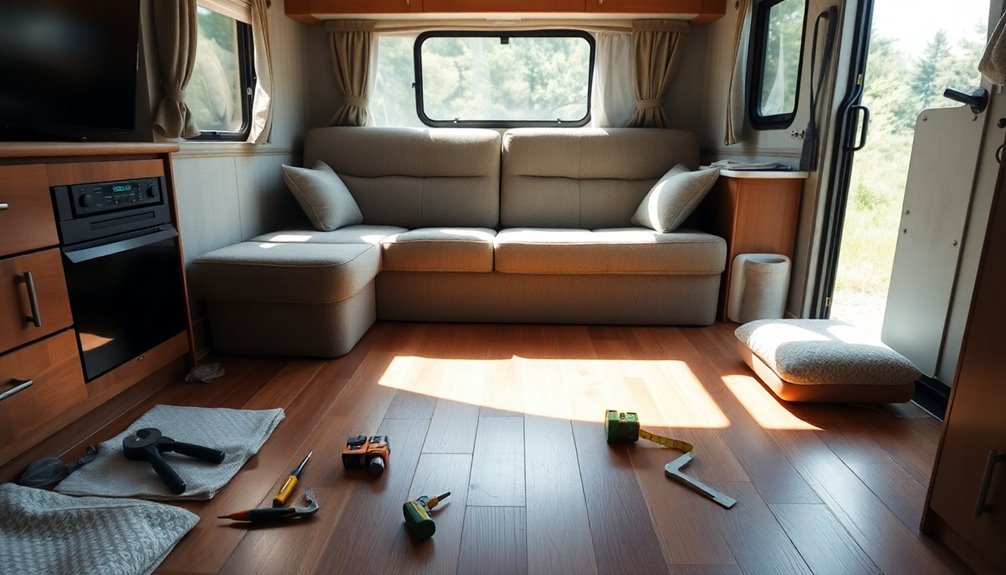
In summary, removing your sofa from an RV requires careful planning and execution to avoid damage and ensure a smooth process. Start by gathering the necessary tools, like a power drill, flashlight, tape measure, and ratchet set, to access and remove the screws holding the sofa together. Make sure to locate all fasteners, which can be hidden under cushions or within the bed mechanism of a hide-a-bed sofa.
Disassembling the sofa into multiple pieces will help it fit through the RV door without causing any damage. Don't underestimate the importance of enlisting the help of a neighbor or friend; their assistance will make lifting and maneuvering the sofa in tight spaces much easier.
Once the sofa is out, remember to collect and store all screws and bolts, as they might come in handy for future projects. If the old sofa is still in good condition, consider disposal or donation options. By following these steps, you’ll not only simplify the removal process but also ensure that your RV remains in top shape for your next adventure. Additionally, you can research local charities or organizations that accept furniture donations, helping those in need while reducing waste. If you’re unsure how to dispose of old sofas, many municipalities offer special collection services or recycling programs that can guide you on the best options available. By taking these considerations into account, you’ll be able to clear out the old furniture responsibly and make room for new, stylish pieces that fit your RV perfectly.
Frequently Asked Questions
Can You Remove a Couch From an RV?
Yes, you can remove a couch from an RV. It usually involves disassembling it into smaller pieces, making it easier to navigate through doorways. You'll need to find hidden fasteners, often located under the cushions or in the bed mechanism. Grab some tools like a power drill and ratchet set. Before you start, measure both the couch and entry points to avoid any issues during the removal process. A little preparation goes a long way!
Are RV Couches Bolted Down?
Yes, RV couches are often bolted down for stability during travel. You'll usually find these fasteners hidden beneath cushions or within the couch's structure. It's important to check all angles, including underneath and behind any storage compartments, to locate screws or bolts. Some models might even use L brackets for added support. If you encounter rivets, you may need to drill them out, as they can't be simply unscrewed.
How to Dismantle a Sofa to Fit Through a Door?
To dismantle a sofa to fit through a door, start by removing all cushions and any attached components. Check for screws or bolts hidden under the fabric or frame, and use a flashlight if needed. If your sofa has arms, locate and unscrew any fasteners. Disassemble the sofa into manageable sections, such as the backrest and seat. Keep all removed screws in a container to ensure you can easily reassemble it later.
Does RV Furniture Come Apart?
Yes, RV furniture often comes apart, which is designed for easier transport and fitting through tight spaces. You'll find that many sofas, especially hide-a-bed models, break down into several sections. Check under cushions and within mechanisms for hidden fasteners like screws and bolts. With the right tools, like a power drill, you can disassemble your furniture efficiently. Just be cautious of any components anchored to the floor or walls to prevent damage.
